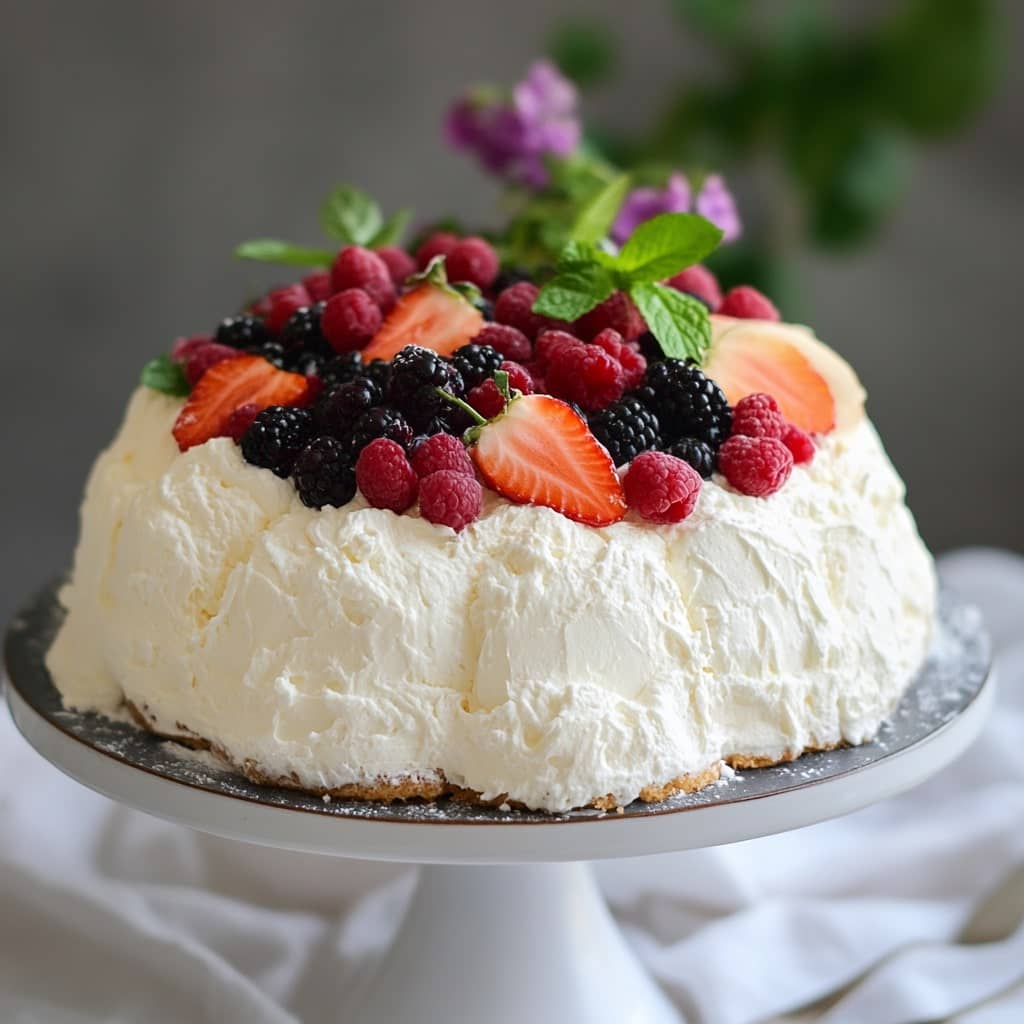Light & Fluffy Yogurt Cloud Cake: A Delicate Delight with a Wholesome Twist
The Light & Fluffy Yogurt Cloud Cake is a beautifully airy dessert that has captured the hearts of home bakers and pastry enthusiasts alike due to its ethereal texture and subtle tang from yogurt. This cake offers a modern, health-conscious twist on traditional sponge cakes by incorporating yogurt, which not only adds moisture but also contributes a gentle tang that balances sweetness perfectly. The cake’s soft, cloud-like crumb makes it ideal for those who crave something light yet satisfying, a perfect treat for any occasion ranging from casual afternoon teas to elegant celebrations. Its rise in popularity is owed to its simplicity, adaptability, and the way it manages to be both comforting and sophisticated, making it a standout in the world of light cakes.
The History of Yogurt Cloud Cake
Yogurt-based cakes have roots in various culinary traditions, especially in Middle Eastern, Mediterranean, and Eastern European cuisines where yogurt is a staple ingredient. The concept of a “cloud cake” is a more recent innovation that emerged as bakers sought lighter alternatives to heavy butter-laden cakes. The name “cloud cake” reflects the cake’s airy texture and delicate nature, often achieved by whipping egg whites separately to incorporate maximum air. By combining this technique with yogurt, bakers created a cake that is moist yet not dense, tender yet structurally sound. Over the last decade, health-conscious trends and the popularity of probiotic-rich foods have boosted the appeal of yogurt cakes. It has evolved into countless variations worldwide, celebrated for both its texture and the health benefits of yogurt.
Ingredients Breakdown
The core of the Yogurt Cloud Cake lies in its balance of wet and dry ingredients that produce its unique texture. Key ingredients include plain yogurt, which imparts moisture and a slight tang; eggs, often separated to whip the whites for volume; sugar to add sweetness; flour to provide structure; baking powder or baking soda as leavening agents; and a small amount of oil or butter for richness. Flavor enhancers such as vanilla extract or lemon zest are frequently added to elevate the aroma and taste. Some recipes incorporate cornstarch or cake flour to ensure tenderness, while others add cream of tartar or vinegar to stabilize egg whites. The yogurt not only contributes flavor but also adds nutritional benefits such as protein, calcium, and probiotics, making this cake a better-for-you choice compared to traditional butter cakes.
Step-by-Step Recipe
- Preheat the Oven and Prepare Pans: Set your oven to 350°F (175°C). Grease and flour your cake pan or line it with parchment paper for easy release.
- Separate the Eggs: Carefully separate the egg whites from the yolks, placing whites in a clean, dry bowl and yolks in another.
- Mix the Wet Ingredients: In a mixing bowl, whisk together the egg yolks, yogurt, oil (or melted butter), sugar, and vanilla extract until smooth and well combined.
- Sift the Dry Ingredients: In a separate bowl, sift together the flour, baking powder, and a pinch of salt to ensure even distribution and remove lumps.
- Combine Wet and Dry: Gradually fold the sifted dry ingredients into the wet mixture, stirring gently until just incorporated.
- Whip Egg Whites: Using a clean mixer bowl and whisk attachment, beat the egg whites with a pinch of cream of tartar or lemon juice until stiff peaks form, indicating maximum air incorporation.
- Fold Whites into Batter: Carefully fold the whipped egg whites into the batter in three additions, using a spatula and gentle motions to preserve the airiness.
- Bake: Pour the batter into the prepared pan and bake for 30-40 minutes or until a toothpick inserted into the center comes out clean and the cake springs back lightly when touched.
- Cool: Let the cake cool in the pan for 10-15 minutes before transferring to a wire rack to cool completely. This prevents condensation and sogginess.
- Serve: Dust with powdered sugar, drizzle with a light glaze, or serve with fresh fruit and whipped cream for added elegance.
Tips for the Perfect Yogurt Cloud Cake
Use fresh, room-temperature eggs as they whip better and incorporate more air. Be patient when whipping egg whites—underwhipped whites won’t provide enough lift, while overwhipping can cause them to dry out and deflate. Gently fold the whites into the batter without rushing to avoid losing volume. Choose a high-quality plain yogurt with a creamy consistency; Greek yogurt can be used but may require thinning with a little milk. Avoid overmixing once the flour is added to maintain the tender crumb. Bake immediately after mixing to ensure maximum rise. Experiment with different flavorings like citrus zest, almond extract, or spices such as cinnamon or cardamom to add subtle complexity. For an even lighter texture, substitute part of the flour with cornstarch or cake flour.
Variations and Customizations
The Yogurt Cloud Cake lends itself well to endless creative variations. Swap plain yogurt for flavored or fruit-infused varieties to impart natural sweetness and unique notes. Add fresh berries, chopped nuts, or chocolate chips folded into the batter for texture contrast. For a dairy-free version, use plant-based yogurt alternatives and egg replacers suitable for baking. Incorporate citrus zest or fresh herbs like lavender or rosemary for a sophisticated twist. Turn it into a layered cake by slicing the baked cake horizontally and filling with fruit preserves, mousse, or flavored whipped cream. Drizzle with glazes such as lemon syrup, chocolate ganache, or honey to enhance flavor and presentation. The cake can also be baked in smaller pans for cupcakes or mini cakes, perfect for portion control and party servings.
Health Considerations and Nutritional Value
Compared to traditional butter or oil-heavy cakes, the Yogurt Cloud Cake offers a lighter alternative with added nutritional benefits. Yogurt contributes protein, calcium, and probiotics, which support digestion and bone health. The cake’s reduced fat content from using yogurt and minimal oil helps lower calories while maintaining moisture and tenderness. Using whole grain or alternative flours can further increase fiber content. Sweetness can be adjusted to taste or replaced partially with natural sweeteners like honey or maple syrup. The high protein content from eggs and yogurt supports satiety, making it a better choice for those watching their diet. However, as with all desserts, moderation is key. Those with dairy or egg allergies can modify ingredients to suit dietary needs without sacrificing texture.
FAQ
Can I use Greek yogurt instead of regular yogurt? Yes, but you may need to thin Greek yogurt with a little milk or water to match the consistency of regular yogurt.
What if I don’t have cream of tartar? Lemon juice or white vinegar can be used as a substitute to stabilize egg whites.
Can I make this cake gluten-free? Yes, by substituting the flour with a gluten-free baking mix or almond flour, though texture may vary slightly.
How do I store the cake? Keep it covered at room temperature for 1-2 days or refrigerate for up to 4 days. For longer storage, freeze the cake well wrapped.
Can I add fruit to the batter? Fresh or frozen fruit can be gently folded in, but avoid very watery fruits to prevent sogginess.
Is this cake suitable for frosting? Due to its delicate texture, it’s best paired with light glazes or whipped toppings rather than heavy frostings.

Light & Fluffy Yogurt Cloud Cake
Ingredients
- 4 large eggs
- 250 grams condensed milk
- 250 grams Greek yogurt
- Juice and zest of half a lemon
- 1 tablespoon powdered sugar optional
Instructions
- Preheat your oven to 160°C (340°F) and line the bottom of a 20 cm springform pan with parchment paper.
- Separate the egg whites and egg yolks into two separate mixing bowls.
- In the bowl with the yolks, combine the condensed milk, Greek yogurt, lemon juice, and lemon zest. Mix until smooth and fully blended, then set aside.
- In the bowl with the egg whites, use an electric mixer or stand mixer to beat them until stiff peaks form.
- Carefully fold the beaten egg whites into the yolk mixture in batches, using a spatula and gentle folding motions to keep the mixture airy.
- Pour the final batter into the prepared springform pan. Place this pan inside a larger baking tray or dish, then fill the outer tray with water until it reaches about 3 cm up the sides of the springform pan.
- Bake for 45 minutes, then turn off the oven and leave the cake inside to cool completely before removing.
- Once cooled, refrigerate the cake for 2 to 3 hours, or preferably overnight, to set.
- Before serving, dust the top with powdered sugar if desired, slice, and enjoy.

